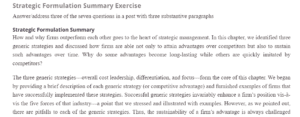Strategic Formulation
Explain why the concept of competitive advantage is central to the study of strategic management
Competitive advantage lies at the heart of strategic management since industry rivalry drives firms to formulate strategies. High competition reduces the company’s market share and dilutes the industry’s profits (Dess et al. 48). Companies develop strategies that leverage them against competitors to survive in such an environment. In this case, strategic management comes in handy in designing business tactics by proposing various approaches, e.g., the generic strategy, comprising cost leadership, differentiation, and focus.
Briefly describe the three generic strategies—overall cost leadership, differentiation, and focus.
Cost leadership aims to reduce operating expenses to enhance the company’s profitability. This strategy entails harnessing economies of scale through producing in bulk. Moreover, it presents a generic product featuring average equality in the market at low rates in generating sales. This strategy is based on volumes due to the low margins earned from a product sale (Dess et al. 35). Product differentiation entails the production of high-quality goods. These products are incorporated with unique features that justify the extra costs. High costs characterize this strategy through substantial investment in research and development to innovate new and unique products. The market leadership strategy aims to garner the largest market share in maximizing profits. In doing so, companies identify customer needs fulfilled by delivering products and services in the market.
Explain the relationship between the three generic strategies and the five forces that determine the average profitability within an industry.
The five forces that determine a company’s average profitability include the threat of new entrants, buyers’ bargaining power, and suppliers’ bargaining power, the threat of substitute products and services, and the intensity of rivalry among competitors in an industry (Dess et al. 46). These five forces shape a company’s strategy selection. For instance, a highly competitive sector calls for implementing a product differentiation strategy that facilitates the incorporation of unique features in a product. Hence, these forces determine the market needs that guide companies in designing strategies.
Works Cited
Dess, Gregory G., Mike W. Peng, and David Lei. “Strategic management: Current issues and future directions.” (2013): 373-374.
ORDER A PLAGIARISM-FREE PAPER HERE
We’ll write everything from scratch
Question
Strategic Formulation Summary Exercise
Answer/address three of the seven questions in a post with three substantive paragraphs

Strategic Formulation
Strategic Formulation Summary
How and why firms outperform each other goes to the heart of strategic management. In this chapter, we identified three generic strategies and discussed how firms are able not only to attain advantages over competitors but also to sustain such advantages over time. Why do some advantages become long-lasting while others are quickly imitated by competitors?
The three generic strategies—overall cost leadership, differentiation, and focus—form the core of this chapter. We began by providing a brief description of each generic strategy (or competitive advantage) and furnished examples of firms that have successfully implemented these strategies. Successful generic strategies invariably enhance a firm’s position vis-à-vis the five forces of that industry—a point that we stressed and illustrated with examples. However, as we pointed out, there are pitfalls to each of the generic strategies. Thus, the sustainability of a firm’s advantage is always challenged because of imitation or substitution by new or existing rivals. Such competitor moves erode a firm’s advantage over time.
We also discussed the viability of combining (or integrating) overall cost leadership and generic differentiation strategies. If successful, such integration can enable a firm to enjoy superior performance and improve its competitive position. However, this is challenging, and managers must be aware of the potential downside risks associated with such an initiative.
We addressed the challenges inherent in determining the sustainability of competitive advantages. Drawing on an example from a manufacturing industry, we discussed both the “pro” and “con” positions as to why competitive advantages are sustainable over a long period of time.
The concept of the industry life cycle is a critical contingency that managers must take into account in striving to create and sustain competitive advantages. We identified the four stages of the industry life cycle—introduction, growth, maturity, and decline—and suggested how these stages can play a role in decisions that managers must make at the business level. These include overall strategies as well as the relative emphasis on functional areas and value-creating activities.
When a firm’s performance severely erodes, turnaround strategies are needed to reverse its situation and enhance its competitive position. We have discussed three approaches—asset cost surgery, selective product and market pruning, and piecemeal productivity improvements.
SUMMARY REVIEW QUESTIONS
- Explain why the concept of competitive advantage is central to the study of strategic management.
- Briefly describe the three generic strategies—overall cost leadership, differentiation, and focus.
- Explain the relationship between the three generic strategies and the five forces that determine the average profitability within an industry.
- What are some of the ways in which a firm can attain a successful turnaround strategy?
- Describe some of the pitfalls associated with each of the three generic strategies.
- Can firms combine the generic strategies of overall cost leadership and differentiation? Why or why not?
- Explain why the industry life-cycle concept is an important factor in determining a firm’s business-level strategy.

